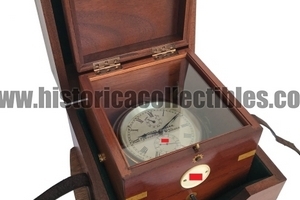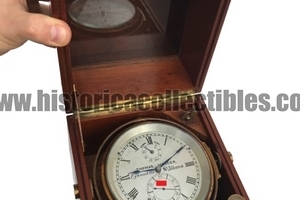Marine Chronometer Thomas Mercer, A. Cairelli, Regia Marina 1941
Chronometer (56h power reserve), produced by Thomas Mercer in 1941. The chronometer is preserved in its original mahogany wood box where it is placed on a tilting system typical of chronometers made for the Navy.
The chronometer was supplied by the A. Cairelli Rome company to the management of the Royal Arsenal of La Spezia upon express request. The above writing is reported in a period document of the "Direction of the Royal Arsenal of La Spezia" which specifies the order number with which the company A. Cairelli undertook to deliver, to the premises of the Reception Committee of the R.A., number three Gimbal suspension chronometers with wooden case and counter-case of identical workmanship.
By observing the document it is possible to read, as in the relevant protocol, the first request, all the specific numbers of the order with the relative characteristics of the chronometers.
This Chronometer is made entirely of satin brass and its hand-wound mechanism has a power reserve of 56 hours.
Unfortunately until today it has not been possible to identify the reason why these three watches were requested and delivered by A. Cairelli to the command of the Royal Arsenal of La Spezia, in a period in which the Italian and English armies were belligerent.
Thomas Mercer Chronometers is a British company specialising in the design and production of bespoke chronometers.
William Walker was born in 1783 and founded a dynasty of watchmakers in St. Helens, Merseyside. His grandson, Thomas Mercer was apprenticed to him. Thomas’s father, Richard Mercer, was a sailmaker, so Thomas had the horological and the nautical in his career ancestry.
The Shackleton Chronometer.
Thomas moved to Liverpool to continue working as a watchmaker in 1843, and thence to London in 1854, to buy a one-way ticket to the USA, in search of new and better prospects. Seeing a chronometer in the window of John Fletcher (chronometer makers), he changed his mind about the USA, asking for work and being hired on the spot. He then founded the eponymous firm Thomas Mercer Chronometers in Islington, London in 1858. This area, (including Clerkenwell and Covent Garden), was a hotbed of creativity and retailing in the chronometer sector. It was highly competitive – as well as the British names of Dent, Frodsham, Reid, Blackie, Johnson.
The British Horological Institute (BHI) was established in Clerkenwell in 1858, supposedly the first professional horological institute ever. Mercer was its honorary treasurer from 1875 to 1895, and “lectured there on the need to modernize the industry and to train young people”. Years later, his grandson would have to be trained in France (see below) owing to lack of a college in the UK.
TMC (Thomas Mercer Chronometers) remained in Clerkenwell until it moved to bigger premises in St. Albans in 1874.
Chronometers were ‘rated’ for accuracy at the annual trials in Greenwich – success was often lucratively rewarded with contracts from private and public sectors. Tom came second at the Greenwich Trials in 1881. The following year, his son Frank Mercer was born, who in later years won Greenwich first prize in 1911 with Mercer 8306. It was bought by Astronomer Royal Frank Dyson for the Greenwich Observatory. Thomas Mercer Chronometers sold many ‘white label’ pieces to middlemen, retailers who would put their own name on the dial of a chronometer made completely by TMC. Many of these were very successful at the Greenwich Trials, but the prizes did not go to TMC. Before judging an horological competition in Paris, Tom caught an infection and died there in 1900.


